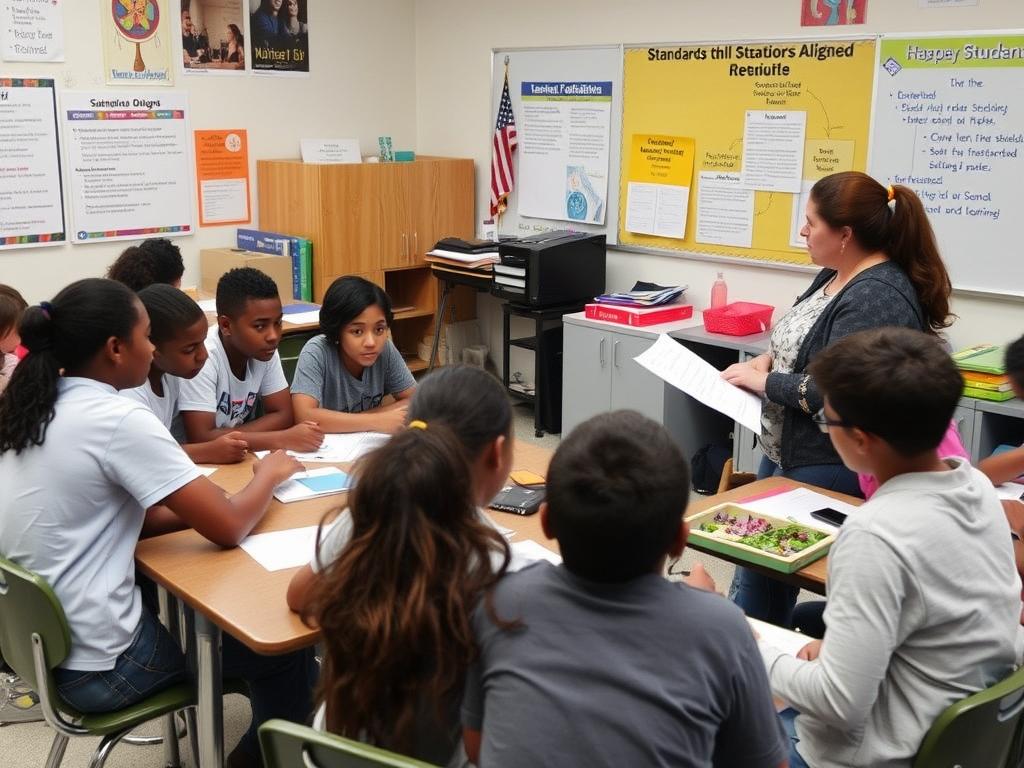In this comprehensive guide, we’ll explore practical strategies for seamlessly connecting standards to your lessons, developing precise learning objectives, and creating assessments that truly measure student mastery. By enhancing these fundamental teacher skills, you’ll create more cohesive, effective instruction that resonates with your students and meets educational requirements.
Why Aligning and Integrating Standards is the Bedrock of Effective Teaching
Standards alignment isn’t just about checking boxes or satisfying administrative requirements. At its core, the process of aligning and integrating standards serves as the foundation for quality instruction that prepares students for future academic and life success.
When you effectively align your teaching with standards, you create a clear roadmap for both yourself and your students. This roadmap ensures that your daily instruction connects to broader educational goals and provides students with the knowledge and skills they need to progress academically.
Research consistently shows that classrooms with strong standards alignment demonstrate improved student outcomes. According to a study by the Education Trust, schools that prioritize rigorous standards implementation see significant gains in student achievement, particularly among historically underserved populations.
Beyond test scores, proper standards alignment helps develop critical teacher skills that enhance your professional practice. These skills include curriculum mapping, assessment design, and differentiated instruction—all essential components of effective teaching.
By mastering the art of aligning and integrating standards, you create learning experiences that are:
- Purposeful and intentional rather than random or disconnected
- Sequenced logically to build knowledge and skills over time
- Focused on essential concepts rather than superficial coverage
- Measurable through meaningful assessments
- Adaptable to diverse student needs while maintaining high expectations
The Mindset Shift: From Coverage to Aligning and Integrating Standards for Mastery
One of the biggest challenges teachers face is moving from a “coverage” mindset to a mastery approach. Many of us feel pressure to rush through curriculum materials, checking off standards as we go without ensuring deep understanding. Effective standards alignment requires a fundamental shift in how we think about our teaching practice.

Instead of asking “Have I covered this standard?” start asking “Have my students truly mastered this standard?” This shift transforms how you approach planning, instruction, and assessment. It’s about developing teacher skills that prioritize depth over breadth and understanding over memorization.
Consider these mindset shifts essential to effective standards alignment:
From:
- Treating standards as a checklist
- Covering content superficially
- Focusing primarily on test preparation
- Working in isolation
- Using standardized approaches for all students
To:
- Using standards as learning progressions
- Ensuring deep conceptual understanding
- Developing transferable skills and knowledge
- Collaborating with colleagues
- Differentiating to meet diverse learning needs
This mindset shift doesn’t happen overnight. It requires ongoing professional development and a commitment to refining your teacher skills. Professional development resources can help you navigate this transition and develop the expertise needed for effective standards integration.
A Step-by-Step Framework for Aligning and Integrating Standards in Your Lesson Design
Creating standards-aligned lessons doesn’t have to be overwhelming. By following a systematic approach, you can develop cohesive learning experiences that connect standards, objectives, activities, and assessments. Here’s a practical framework to guide your planning process:
- Identify Priority Standards: Not all standards carry equal weight. Identify the most essential standards that represent foundational knowledge and skills students need for future learning. These become your primary focus.
- Unpack the Standards: Break down each standard into its component parts. What specific knowledge and skills are embedded within it? What does mastery look like? This unpacking process is a critical teacher skill that forms the foundation for effective lesson design.
- Create Clear Learning Objectives: Translate standards into concrete, measurable learning objectives that specify what students will know and be able to do. Well-crafted objectives serve as the bridge between broad standards and daily instruction.
- Design Aligned Assessments: Create formative and summative assessments that directly measure student progress toward mastery of the standards. These assessments should provide meaningful data to guide your instruction.
- Plan Engaging Learning Activities: Develop instructional activities that build the knowledge and skills specified in your learning objectives. These activities should provide multiple pathways to mastery to accommodate diverse learning needs.
- Implement with Flexibility: Execute your plan while remaining responsive to student needs. Use formative assessment data to make real-time adjustments to your instruction.
- Reflect and Refine: After teaching, reflect on what worked and what didn’t. Use this reflection to refine your approach to aligning and integrating standards in future lessons.
This framework isn’t linear—it’s cyclical. As you develop your teacher skills in standards alignment, you’ll find yourself moving back and forth between these steps, making adjustments based on student needs and learning outcomes.
Ready to Master Standards Integration?
Take your standards alignment skills to the next level with our comprehensive course. Learn practical strategies for integrating standards effectively into your daily teaching practice.
Unpacking Standards: The First Step to Aligning and Integrating Standards Successfully
Before you can effectively align your teaching with standards, you need to thoroughly understand what those standards actually require. This process, often called “unpacking” or “deconstructing” standards, is a fundamental teacher skill that transforms vague or complex standards into clear, teachable components.

Here’s how to effectively unpack standards:
1. Identify the Key Components
Start by breaking down the standard into its essential parts:
- Content: What subject matter must students understand?
- Skills: What must students be able to do?
- Context: In what setting or circumstances should students demonstrate this knowledge/skill?
- Cognitive Level: What depth of thinking is required (recall, application, analysis, etc.)?
2. Analyze the Verbs
Pay close attention to the action verbs in the standard. These verbs indicate the cognitive level required and help define what mastery looks like:
| Cognitive Level | Common Verbs | What It Means for Instruction |
| Remember/Recall | Define, list, recall, identify | Basic memorization and recall activities |
| Understand | Explain, describe, summarize | Activities that demonstrate comprehension |
| Apply | Use, implement, solve | Practical application in new contexts |
| Analyze | Compare, contrast, examine | Breaking information into parts to explore relationships |
| Evaluate | Judge, critique, justify | Making judgments based on criteria |
| Create | Design, construct, develop | Producing original work or new perspectives |
3. Determine the Learning Progression
Identify what students need to know and be able to do before they can master this standard. This helps you sequence your instruction effectively and ensure students have the necessary foundation.
Unpacking standards is a critical teacher skill that takes practice to master. As you develop this skill, you’ll find it easier to translate standards into meaningful learning experiences for your students. Remember that our course on Integrating Standards Effectively provides in-depth guidance on this process.
Crafting Precise Learning Objectives that Show You’re Truly Aligning and Integrating Standards
Learning objectives serve as the bridge between broad standards and daily classroom activities. Well-crafted objectives make your standards alignment visible and provide clear direction for both teaching and assessment. Developing this teacher skill is essential for effective standards integration.
Effective learning objectives share these characteristics:
- Student-centered: Focus on what students will learn, not what teachers will teach
- Measurable: Include criteria for determining whether students have achieved the objective
- Aligned: Directly connected to standards and assessments
- Realistic: Achievable within the time and resources available
- Time-bound: Specify when students should achieve mastery
The ABCD method provides a helpful framework for writing clear objectives:
Audience: Who will achieve the objective? (usually “students” or “learners”)
Behavior: What observable action will demonstrate learning? (use action verbs)
Condition: Under what circumstances will learning occur?
Degree: To what level must the behavior be performed?
Here’s an example of transforming a standard into specific learning objectives:
Standard: Analyze how particular elements of a story or drama interact (e.g., how setting shapes the characters or plot).
Learning Objectives:
- Students will identify at least three ways the setting influences character development in our core novel, citing specific textual evidence.
- Students will explain how changing the setting would alter the plot, providing at least two specific examples.
- Students will compare the interaction of story elements in two different texts, noting at least three similarities and differences.
Notice how these objectives break down the standard into specific, measurable learning targets. They clarify exactly what students need to demonstrate and provide clear criteria for success. This level of specificity is a hallmark of strong teacher skills in curriculum design.
When sharing objectives with students, consider creating “student-friendly” versions that use accessible language while maintaining alignment with standards. This transparency helps students understand what they’re expected to learn and why it matters.
Choosing Activities and Assessments that Prove Your Aligning and Integrating Standards Efforts Are Working
The true test of effective standards alignment lies in your instructional activities and assessments. These elements must directly connect to your learning objectives and provide evidence that students are mastering the standards. Developing these teacher skills ensures that your classroom practice truly reflects your standards alignment intentions.
Designing Aligned Activities
When selecting or creating learning activities, ask yourself these questions:
- Does this activity directly help students master the targeted standard?
- Does it address the appropriate cognitive level (recall, application, analysis, etc.)?
- Does it provide opportunities for students to practice the specific skills outlined in the learning objectives?
- Does it accommodate different learning styles and needs?
- Does it engage students in meaningful learning rather than busy work?
The most effective activities provide multiple pathways to mastery while maintaining clear alignment with standards. This balance requires sophisticated teacher skills that develop with experience and intentional practice.
Creating Aligned Assessments
Assessments should directly measure student progress toward mastery of the standards. Consider these principles when designing assessments:
Formative Assessments
- Provide ongoing feedback during the learning process
- Help identify misconceptions early
- Guide instructional adjustments
- Examples: exit tickets, quizzes, discussions
Summative Assessments
- Evaluate mastery at the end of instruction
- Provide evidence of standard attainment
- Inform future teaching cycles
- Examples: tests, projects, performances
Regardless of the assessment type, ensure that it:
- Directly measures the learning objectives
- Requires the same cognitive level as the standard
- Provides clear evidence of student learning
- Includes appropriate accommodations for diverse learners
According to a study by the Association for Supervision and Curriculum Development, assessments that are tightly aligned with standards and instruction lead to more accurate measurements of student learning and more effective instructional decisions.
Enhance Your Assessment Design Skills
Looking to create more effective standards-aligned assessments? Our professional development resources can help you design assessments that accurately measure student mastery.
Sharpening Your Teacher Skills Through the Practice of Aligning and Integrating Standards
The process of aligning and integrating standards into your teaching practice develops critical professional competencies that enhance your effectiveness in the classroom. These teacher skills extend far beyond simple standards compliance—they represent the core of expert teaching.

Here are key teacher skills that develop through intentional standards alignment work:
Curriculum Mapping
The ability to see the big picture of learning across a year or multiple years, ensuring logical progression and avoiding gaps or redundancies.
Assessment Literacy
The capacity to design and use assessments that accurately measure student learning and provide actionable data for instructional decisions.
Differentiation
The skill of adapting instruction to meet diverse learning needs while maintaining alignment with grade-level standards.
These teacher skills don’t develop overnight. They require intentional practice, reflection, and ongoing professional learning. As you engage in the work of aligning and integrating standards, you’ll find these competencies strengthening over time.
Consider these strategies for developing your standards alignment skills:
- Collaborative planning: Work with colleagues to analyze standards and design aligned instruction. This collaborative approach leverages diverse perspectives and expertise.
- Peer observation: Observe how other teachers align their instruction with standards. Look for effective practices you can adapt for your own classroom.
- Reflective practice: Regularly reflect on the alignment between your standards, objectives, activities, and assessments. Identify areas for improvement and adjust accordingly.
- Professional learning: Seek out professional development opportunities focused on standards alignment. These experiences can provide new strategies and deepen your understanding.
Remember that developing these teacher skills is a journey, not a destination. Even experienced educators continue to refine their approach to aligning and integrating standards as they grow professionally.
Common Pitfalls to Avoid When Aligning and Integrating Standards
Even with the best intentions, teachers often encounter challenges when aligning their instruction with standards. Awareness of these common pitfalls can help you navigate the standards alignment process more effectively and develop stronger teacher skills.
Effective Practices
- Focusing on depth over breadth
- Connecting standards to meaningful contexts
- Using standards as a framework, not a script
- Differentiating while maintaining high expectations
- Designing assessments that truly measure standards
Common Pitfalls
- Covering too many standards superficially
- Teaching skills in isolation without context
- Following standards rigidly without adaptation
- Lowering expectations instead of providing support
- Creating assessments disconnected from standards
Let’s explore these pitfalls in more detail:
1. The Coverage Trap
Many teachers feel pressured to “cover” all standards, leading to superficial treatment of important concepts. Instead of racing through content, focus on priority standards that represent foundational knowledge and skills. This approach allows for the depth needed for true mastery.
2. Isolated Skill Development
Teaching skills in isolation can lead to fragmented learning. Effective standards alignment connects skills to meaningful contexts and shows how they relate to broader concepts. This integration helps students see the relevance and application of what they’re learning.
3. Rigid Adherence
Standards provide guidance, not a script. Avoid interpreting standards so rigidly that you miss opportunities for authentic learning or fail to respond to student needs. Developing teacher skills in standards interpretation helps you maintain alignment while adapting to your specific classroom context.
4. Misaligned Assessments
A common pitfall is creating assessments that don’t truly measure the standards you’re teaching. Ensure that your assessments require the same cognitive level and address the same content as the standards themselves.
Navigating these challenges requires ongoing reflection and refinement of your teacher skills. Remember that effective standards alignment is a process of continuous improvement, not a one-time achievement.
Bringing It All Together: Your Journey to Mastering Standards Alignment
The process of aligning and integrating standards into your teaching practice is both challenging and rewarding. As you develop these essential teacher skills, you create more cohesive, effective learning experiences for your students while enhancing your own professional practice.
Remember these key principles as you continue your standards alignment journey:
- Start with a clear understanding of the standards themselves
- Create specific, measurable learning objectives that bridge standards and instruction
- Design activities and assessments that directly align with your objectives
- Remain flexible and responsive to student needs while maintaining alignment
- Reflect on your practice and continuously refine your approach
The work of aligning and integrating standards is never truly finished. As standards evolve, student needs change, and your own teacher skills develop, your approach to standards alignment will continue to grow and improve.
By committing to this ongoing process of professional growth, you not only enhance your effectiveness as an educator but also create more meaningful, coherent learning experiences for your students. And ultimately, that’s what great teaching is all about.
Take Your Standards Integration to the Next Level
Ready to enhance your teacher skills in standards alignment? Our comprehensive course provides practical strategies, expert guidance, and ready-to-use resources for effectively integrating standards into your daily teaching practice.




